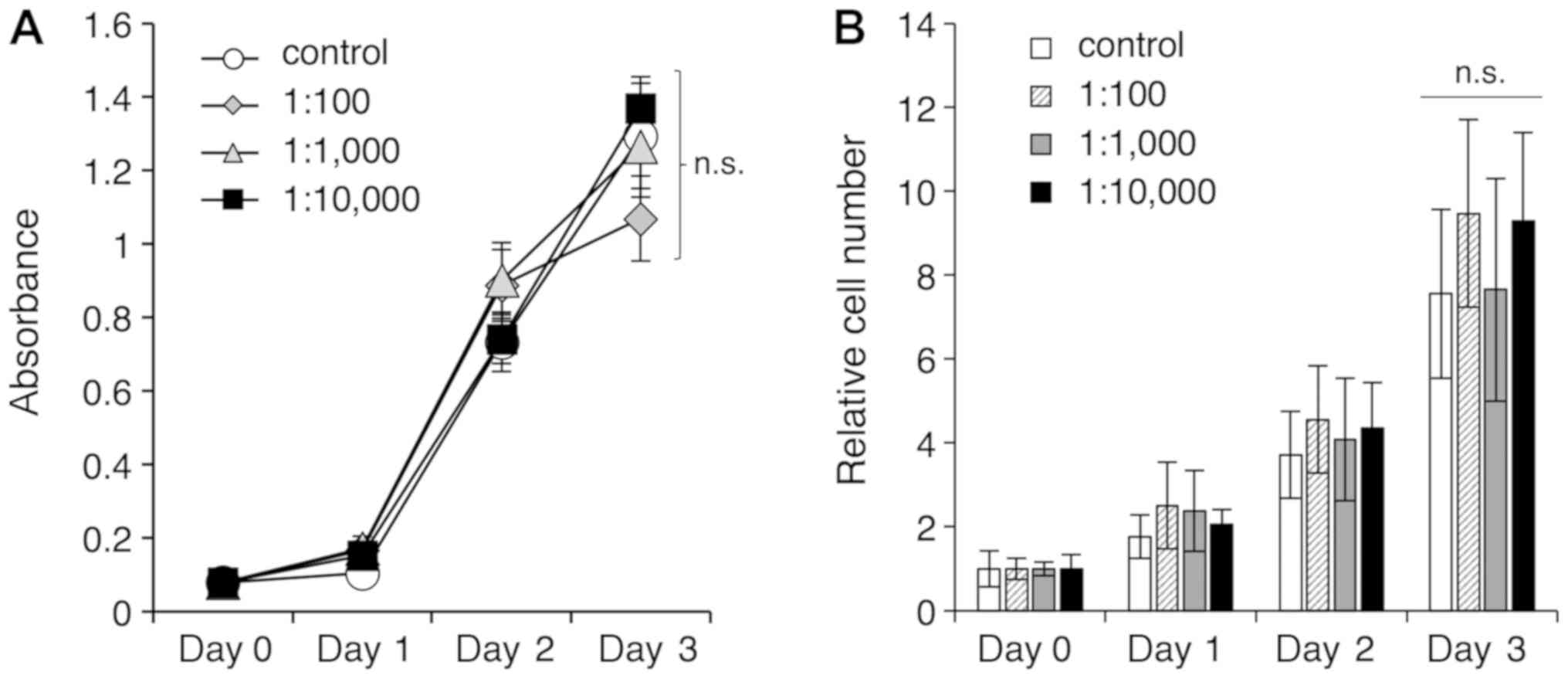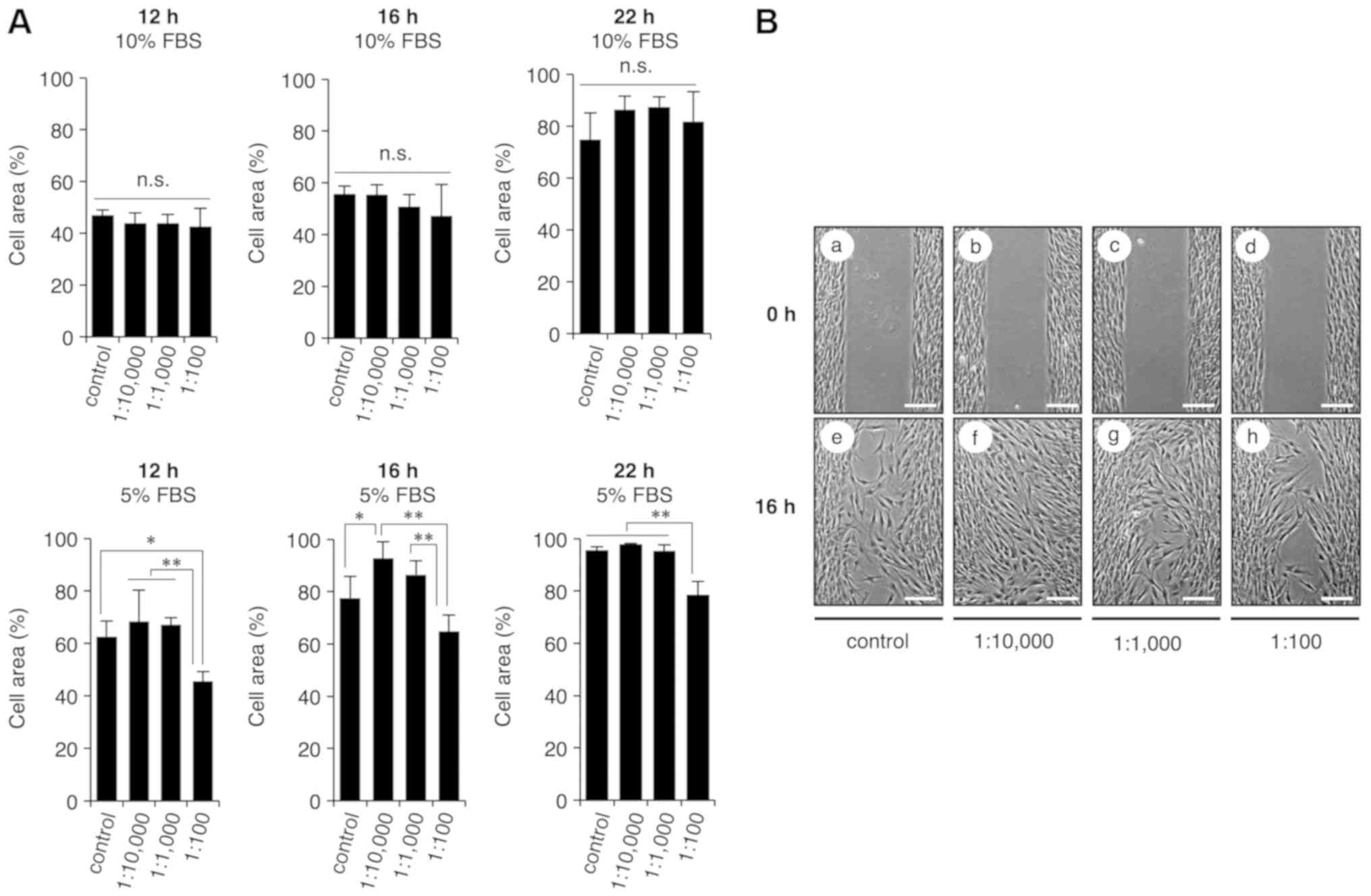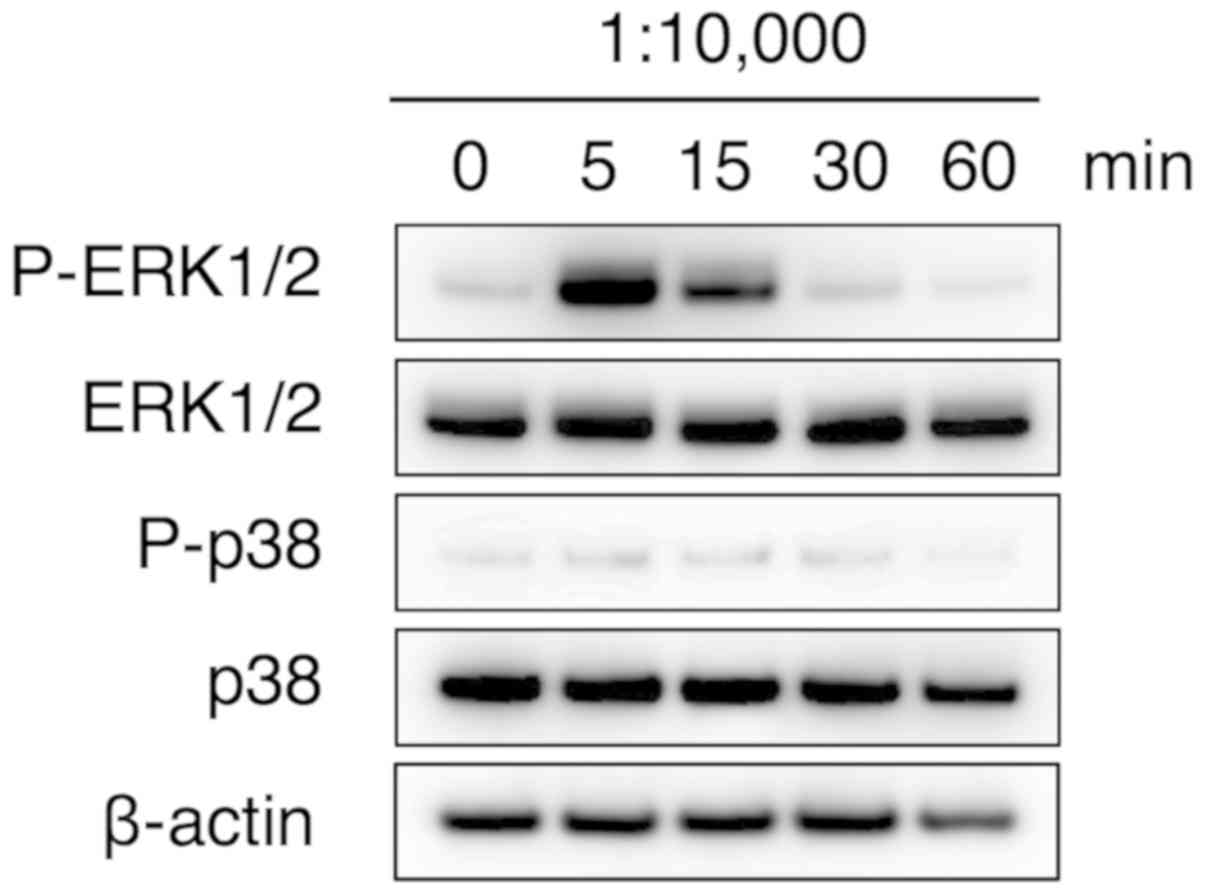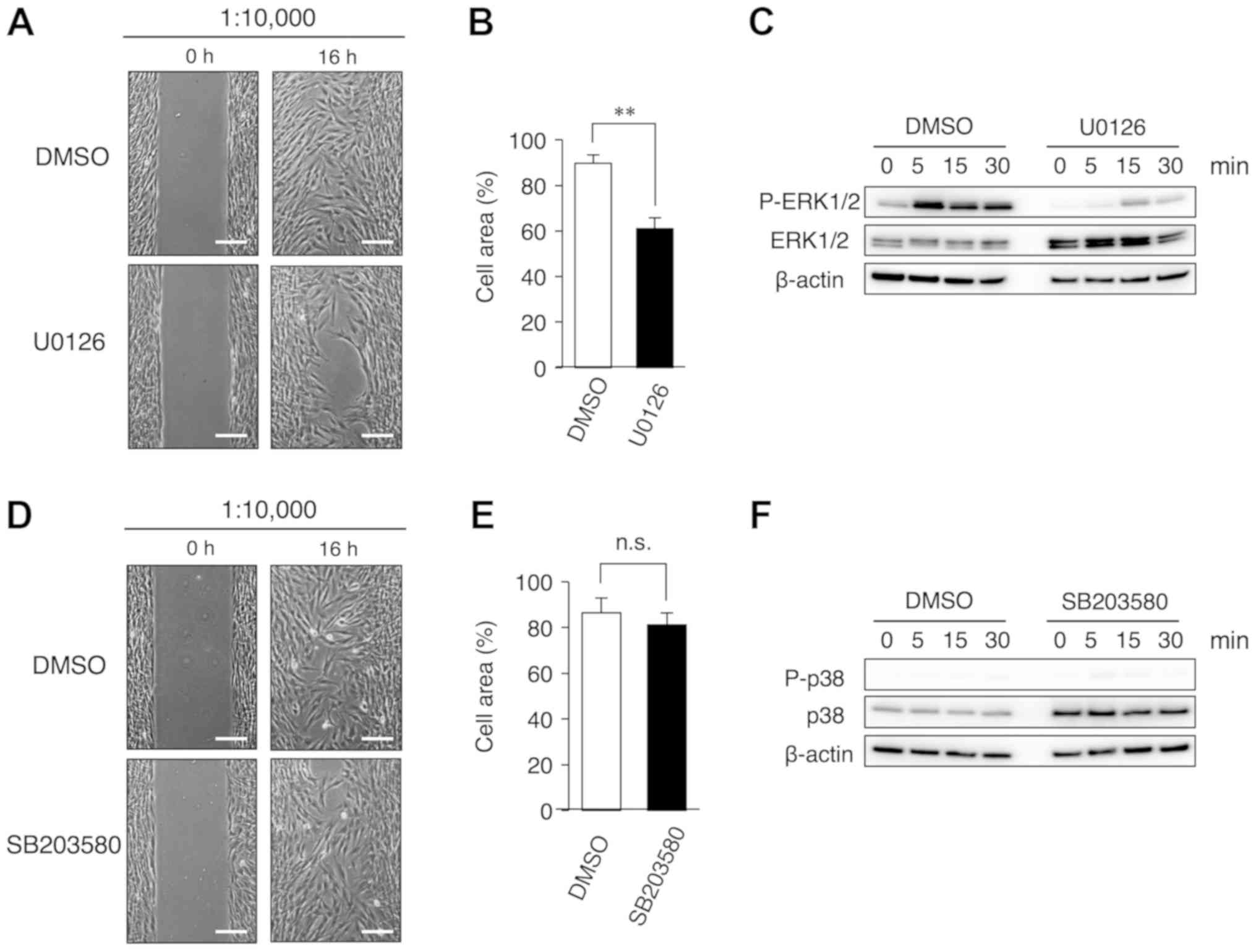|
1
|
Ara T, Kurata K, Hirai K, Uchihashi T,
Uematsu T, Imamura Y, Furusawa K, Kurihara S and Wang PL: Human
gingival fibroblasts are critical in sustaining inflammation in
periodontal disease. J Periodontal Res. 44:21–27. 2009. View Article : Google Scholar : PubMed/NCBI
|
|
2
|
Soliman AM, Das S, Abd Ghafar N and Teoh
SL: Role of MicroRNA in proliferation phase of wound healing. Front
Genet. 9:382018. View Article : Google Scholar : PubMed/NCBI
|
|
3
|
Heun Y, Pogoda K, Anton M, Pircher J,
Pfeifer A, Woernle M, Ribeiro A, Kameritsch P, Mykhaylyk O, Plank
C, et al: HIF-1α dependent wound healing angiogenesis in vivo can
be controlled by site-specific lentiviral magnetic targeting of
SHP-2. Mol Ther. 25:1616–1627. 2017. View Article : Google Scholar : PubMed/NCBI
|
|
4
|
Ikemura K, Tay FR, Endo T and Pashley DH:
A review of chemical-approach and ultramorphological studies on the
development of fluoride-releasing dental adhesives comprising new
pre-reacted glass ionomer (PRG) fillers. Dent Mater J. 27:315–339.
2008. View Article : Google Scholar : PubMed/NCBI
|
|
5
|
Salmerón-Valdés EN, Scougall-Vilchis RJ,
Alanis-Tavira J and Morales-Luckie RA: Comparative study of
fluoride released and recharged from conventional pit and fissure
sealants versus surface prereacted glass ionomer technology. J
Conserv Dent. 19:41–45. 2016. View Article : Google Scholar : PubMed/NCBI
|
|
6
|
Itota T, Carrick TE, Yoshiyama M and
McCabe JF: Fluoride release and recharge in giomer, compomer and
resin composite. Dent Mater. 20:789–795. 2004. View Article : Google Scholar : PubMed/NCBI
|
|
7
|
Alsayed EZ, Hariri I, Nakashima S, Shimada
Y, Bakhsh TA, Tagami J and Sadr A: Effects of coating materials on
nanoindentation hardness of enamel and adjacent areas. Dent Mater.
32:807–816. 2016. View Article : Google Scholar : PubMed/NCBI
|
|
8
|
Nomura R, Morita Y, Matayoshi S and Nakano
K: Inhibitory effect of surface pre-reacted glass-ionomer (S-PRG)
eluate against adhesion and colonization by Streptococcus
mutans. Sci Rep. 8:50562018. View Article : Google Scholar : PubMed/NCBI
|
|
9
|
Tsutsumi C, Takakuda K and Wakabayashi N:
Reduction of Candida biofilm adhesion by incorporation of
prereacted glass ionomer filler in denture base resin. J Dent.
44:37–43. 2016. View Article : Google Scholar : PubMed/NCBI
|
|
10
|
Kawasaki K and Kambara M: Effects of
ion-releasing tooth-coating material on demineralization of bovine
tooth enamel. Int J Dent. 2014:4631492014. View Article : Google Scholar : PubMed/NCBI
|
|
11
|
Hashimura T, Yamada A, Iwamoto T, Arakaki
M, Saito K and Fukumoto S: Application of a tooth-surface coating
material to teeth with discolored crowns. Pediat Dent J. 23:44–50.
2013. View Article : Google Scholar
|
|
12
|
Hirayama K, Hanada T, Hino R, Saito K,
Kobayashi M, Arakaki M, Chiba Y, Nakamura N, Sakurai T, Iwamoto T,
et al: Material properties on enamel and fissure of surface
pre-reacted glass-ionomer filler-containing dental sealant. Pediat
Dent J. 28:87–95. 2018. View Article : Google Scholar
|
|
13
|
Iwamatsu-Kobayashi Y, Abe S, Fujieda Y,
Orimoto A, Kanehira M, Handa K, Venkataiah VS, Zou W, Ishikawa M
and Saito M: Metal ions from S-PRG filler have the potential to
prevent periodontal disease. Clin Exp Dent Res. 3:126–133. 2017.
View Article : Google Scholar : PubMed/NCBI
|
|
14
|
Huang C, Jacobson K and Schaller MD: MAP
kinases and cell migration. J Cell Sci. 117:4619–4628. 2004.
View Article : Google Scholar : PubMed/NCBI
|
|
15
|
Iwatsuki M and Matsuoka M:
Fluoride-induced c-Fos expression in MC3T3-E1 osteoblastic cells.
Toxicol Mech Methods. 26:132–138. 2016. View Article : Google Scholar : PubMed/NCBI
|
|
16
|
Ware MF, Wells A and Lauffenburger DA:
Epidermal growth factor alters fibroblast migration speed and
directional persistence reciprocally and in a matrix-dependent
manner. J Cell Sci. 111:2423–2432. 1998.PubMed/NCBI
|
|
17
|
Tan SS, Yeo XY, Liang ZC, Sethi SK and Tay
SSW: Stromal vascular fraction promotes fibroblast migration and
cellular viability in a hyperglycemic microenvironment through
up-regulation of wound healing cytokines. Exp Mol Pathol.
104:250–255. 2018. View Article : Google Scholar : PubMed/NCBI
|
|
18
|
Suetsugu S, Yamazaki D, Kurisu S and
Takenawa T: Differential roles of WAVE1 and WAVE2 in dorsal and
peripheral ruffle formation for fibroblast cell migration. Dev
Cell. 5:595–609. 2003. View Article : Google Scholar : PubMed/NCBI
|
|
19
|
Acharya PS, Majumdar S, Jacob M, Hayden J,
Mrass P, Weninger W, Assoian RK and Puré E: Fibroblast migration is
mediated by CD44-dependent TGF beta activation. J Cell Sci.
121:1393–1402. 2008. View Article : Google Scholar : PubMed/NCBI
|
|
20
|
Nakamura N, Yamada A, Iwamoto T, Arakaki
M, Tanaka K, Aizawa S, Nonaka K and Fukumoto S: Two-year clinical
evaluation of flowable composite resin containing pre-reacted
glass-ionomer. Pediat Dent J. 19:89–97. 2008. View Article : Google Scholar
|
|
21
|
Billington RW, Williams JA and Pearson GJ:
Ion processes in glass ionomer cements. J Dent. 34:544–555. 2006.
View Article : Google Scholar : PubMed/NCBI
|
|
22
|
Yokel RA: The toxicology of aluminum in
the brain: A review. Neurotoxicology. 21:813–828. 2000.PubMed/NCBI
|
|
23
|
Lau KH, Yoo A and Wang SP: Aluminum
stimulates the proliferation and differentiation of osteoblasts in
vitro by a mechanism that is different from fluoride. Mol Cell
Biochem. 105:93–105. 1991.PubMed/NCBI
|
|
24
|
Saldaña L, Barranco V, García-Alonso MC,
Vallés G, Escudero ML, Munuera L and Vilaboa N: Concentration-
dependent effects of titanium and aluminium ions released from
thermally oxidized Ti6Al4V alloy on human osteoblasts. J Biomed
Mater Res A. 77:220–229. 2006. View Article : Google Scholar : PubMed/NCBI
|
|
25
|
Benderdour M, Hess K, Dzondo-Gadet M,
Nabet P, Belleville F and Dousset B: Boron modulates extracellular
matrix and TNF alpha synthesis in human fibroblasts. Biochem
Biophys Res Commun. 246:746–751. 1998. View Article : Google Scholar : PubMed/NCBI
|
|
26
|
Nzietchueng RM, Dousset B, Franck P,
Benderdour M, Nabet P and Hess K: Mechanisms implicated in the
effects of boron on wound healing. J Trace Elem Med Biol.
16:239–244. 2002. View Article : Google Scholar : PubMed/NCBI
|
|
27
|
Denker SP and Barber DL: Cell migration
requires both ion translocation and cytoskeletal anchoring by the
Na-H exchanger NHE1. J Cell Biol. 159:1087–1096. 2002. View Article : Google Scholar : PubMed/NCBI
|
|
28
|
Quignard S, Coradin T, Powell JJ and
Jugdaohsingh R: Silica nanoparticles as sources of silicic acid
favoring wound healing in vitro. Colloids Surf B Biointerfaces.
155:530–537. 2017. View Article : Google Scholar : PubMed/NCBI
|
|
29
|
Kawase T and Suzuki A: Studies on the
transmembrane migration of fluoride and its effects on
proliferation of L-929 fibroblasts (L cells) in vitro. Arch Oral
Biol. 34:103–107. 1989. View Article : Google Scholar : PubMed/NCBI
|
|
30
|
Aimaiti A, Maimaitiyiming A, Boyong X, Aji
K, Li C and Cui L: Low-dose strontium stimulates osteogenesis but
high-dose doses cause apoptosis in human adipose-derived stem cells
via regulation of the ERK1/2 signaling pathway. Stem Cell Res Ther.
8:2822017. View Article : Google Scholar : PubMed/NCBI
|
|
31
|
Murphy LO and Blenis J: MAPK signal
specificity: The right place at the right time. Trends Biochem Sci.
31:268–275. 2006. View Article : Google Scholar : PubMed/NCBI
|
|
32
|
Hedges JC, Dechert MA, Yamboliev IA,
Martin JL, Hickey E, Weber LA and Gerthoffer WT: A role for
p38(MAPK)/HSP27 pathway in smooth muscle cell migration. J Biol
Chem. 274:24211–24219. 1999. View Article : Google Scholar : PubMed/NCBI
|
|
33
|
Kotlyarov A, Yannoni Y, Fritz S, Laass K,
Telliez JB, Pitman D, Lin LL and Gaestel M: Distinct cellular
functions of MK2. Mol Cell Biol. 22:4827–4835. 2002. View Article : Google Scholar : PubMed/NCBI
|
|
34
|
Konson A, Pradeep S, D'Acunto CW and Seger
R: Pigment epithelium-derived factor and its phosphomimetic mutant
induce JNK-dependent apoptosis and P38-mediated migration arrest.
Cell Physiol Biochem. 49:512–529. 2018. View Article : Google Scholar : PubMed/NCBI
|
|
35
|
Kedici SP, Aksüt AA, Kílíçarslan MA,
Bayramoğlu G and Gökdemir K: Corrosion behaviour of dental metals
and alloys in different media. J Oral Rehabil. 25:800–808. 1998.
View Article : Google Scholar : PubMed/NCBI
|
|
36
|
Porcayo-Calderon J, Casales-Diaz M,
Salinas-Bravo VM and Martinez-Gomez L: Corrosion performance of
Fe-Cr-Ni alloys in artificial saliva and mouthwash solution.
Bioinorg Chem Appl. 2015:9308022015. View Article : Google Scholar : PubMed/NCBI
|
|
37
|
Syed M, Chopra R and Sachdev V: Allergic
reactions to dental materials-a systematic review. J Clin Diagn
Res. 9:ZE04–ZE09. 2015.PubMed/NCBI
|
|
38
|
Zhang X, Wei LC, Wu B, Yu LY, Wang XP and
Liu Y: A comparative analysis of metal allergens associated with
dental alloy prostheses and the expression of HLA-DR in gingival
tissue. Mol Med Rep. 13:91–98. 2016. View Article : Google Scholar : PubMed/NCBI
|
|
39
|
Leggat PA and Kedjarune U: Toxicity of
methyl methacrylate in dentistry. Int Dent J. 53:126–131. 2003.
View Article : Google Scholar : PubMed/NCBI
|
|
40
|
Marquardt W, Seiss M, Hickel R and Reichl
FX: Volatile methacrylates in dental practices. J Adhes Dent.
11:101–107. 2009.PubMed/NCBI
|
|
41
|
Nik TH, Shahroudi AS, Eraghihzadeh Z and
Aghajani F: Comparison of residual monomer loss from cold-cure
orthodontic acrylic resins processed by different polymerization
techniques. J Orthod. 41:30–37. 2014. View Article : Google Scholar : PubMed/NCBI
|
|
42
|
Williams DF: There is no such thing as a
biocompatible material. Biomaterials. 35:10009–10014. 2014.
View Article : Google Scholar : PubMed/NCBI
|
|
43
|
Hench LL and Polak JM: Third-generation
biomedical materials. Science. 295:1014–1017. 2002. View Article : Google Scholar : PubMed/NCBI
|
|
44
|
Oliveira HL, Da Rosa WLO, Cuevas-Suárez
CE, Carreño NLV, da Silva AF, Guim TN, Dellagostin OA and Piva E:
Histological evaluation of bone repair with hydroxyapatite: A
systematic review. Calcif Tissue Int. 101:341–354. 2017. View Article : Google Scholar : PubMed/NCBI
|


















